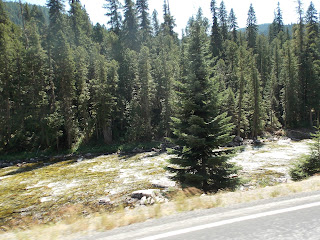We had a very long day traveling here to Walla Walla on Thursday. Part of the problem was again having to climb a couple of mountain passes. However, it was on a scenic by-way- Highway 12 out of Montana, through Idaho and into Washington. That is our rig pictured above, parked next to towering rocky canyon walls. Our drive took us through river canyons (as the Lochsa River Canyon). On the left side of the road we had wonderful sightings of mountain rivers and creeks; some very shallow and clear, and others running deep with white water rapids. While I was keeping an eye on the scenery, I was also beginning a book by Yann Martel- beatrice and virgil. Trying thus to multi-task made for an unusual day. Just as I found the book a bit strange, I also discovered that each section of the river we were following had strange names (which probably could be stories in themselves). I will mention a few here: Smoked Cedar Creek, Dead Man's Creek, Split Creek, Tumbling Falls Creek, Post Office Creek, Fire Creek- to name but a few.
Other road signs had equally fascinating names. We drove through the Pink House Recreation Area, as well as Heart of the Monster Site. I just had to search for information concerning the latter one, and discovered it is the legendary birthplace of the Nez Perce tribe. It is their culture's creation story. Coming into the state of Washington we found ourselves in the foothills of the Blue Mountains and the scenery changed dramatically. Now surrounding us were low-lying hills with sparse vegetation.




No comments:
Post a Comment